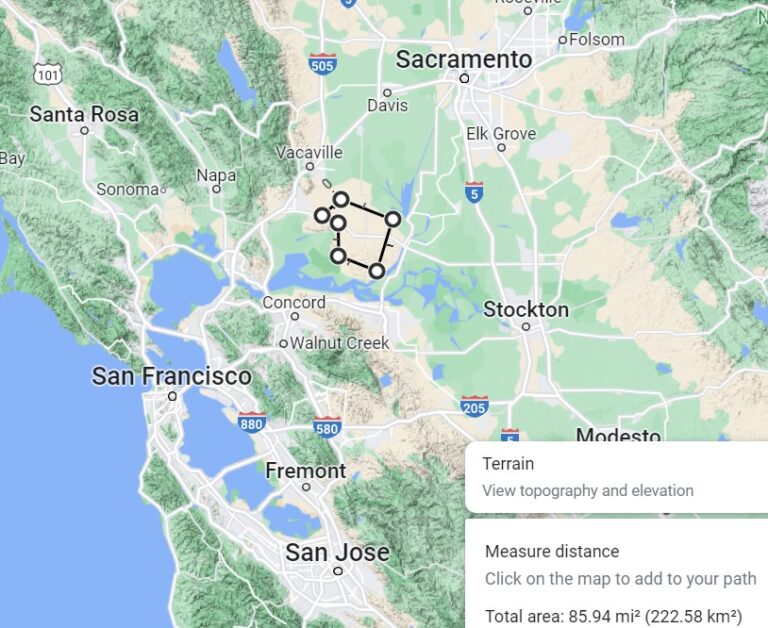Physical Address
304 North Cardinal St.
Dorchester Center, MA 02124
Physical Address
304 North Cardinal St.
Dorchester Center, MA 02124

Conor Dougherty and Erin Griffith revealed the identities behind a Silicon Valley investor group, Flannery Associates, that had gradually purchased 55,000 acres of ranchland near Travis Air Force Base in Solano County, California. Scale check: that’s a lot of land. San Francisco is 30,000 acres; San Jose is 116,000. Earlier WSJ reporting includes a map of Flannery’s holdings, which are predictably a bit scattered. To zoom out and give a scale comparison, I outlined a 55,000 acre contiguous blob around the core of the Flannery holdings. At the density of nearby Vacaville, this much land would be home to nearly 300,000 people. If it matched Oakland, it would be more than twice that. Many, especially at the Charter Cities Institute, have written about new cities. But can a new city ever be truly “market urbanist”? Or is the intent to create a city necessarily an exercise in centralized planning? Monopoly Bizarrely, the one actor who could most purely create a market-driven city is the government: It could use eminent domain to assemble only the land needed for new infrastructure, tax all landowners fairly, and allow competition among landowners to compete via development and land use. At the opposite extreme, when a profit-maximizing private actor owns all the land, it faces a unique form of the monopolist’s tradeoff: The longer it holds onto land, the higher price it can charge on sale, but the less that land contributes to urban growth. One way to sidestep this tradeoff is for the monopolist to develop land itself. But of course that concentrates risk, and the cost of development is at least a hundred times more than the land cost (which appears to have averaged about $16,000 per acre in Solano County). Zero to one So what’s a mega-landowner to do? I’d start by […]

Discussions about land use reform focus on policy – as they should. Overcoming NIMBYism will require deep legal, political, and regulatory reform. That said, entrepreneurs may be helping to short circuit the perverse incentives that give rise to NIMBYism in the first place. New companies may be encouraging homeowners to embrace density and helping to break the tie between homeownership and anti-deveolpment attitudes in the process. Creating Demand for Density Belong is an early stage startup making it easier for homeowners to rent out their single family home. The main use case is that of a homeowner renting (instead of selling) after a move. A lot goes into becoming a landlord and Belong’s elevator pitch is that they simplify the process. The company’s customers access insurance, connect to contractors for repair and renovation, get help with listing, and find anything else they need all in one place. To the extent they’re successful, they’ll be creating a class of small scale landlords with every reason to develop missing middle housing. Transforming the family home from a speculative asset to one producing a monthly stream of revenue makes ADUs and duplexes more attractive. More units mean more tenants and therefore better monthly returns. And once an owner is no longer an owner-occupier, “neighborhood character” concerns become less salient as well. That said, this is admittedly speculative. Whether single property landlords will be as YIMBY as I suspect is an empirical question for the future. More immediate, though, are the incentives another new startup is creating for homeowners across California. Densification as the Path to Homeownership Homestead is a property developer that’s using legislation like California’s SB9 and SB10 to build housing. They work with homeowners interested in the upside of doing a lot split and adding housing like a duplex or an […]

Monday, Y-Combinator, an early-stage technology startup incubator, announced it will “study building new, better cities.” Some existing cities will get bigger and there’s important work being done by smart people to improve them. We also think it’s possible to do amazing things given a blank slate. Our goal is to design the best possible city given the constraints of existing laws. They are embarking on an undertaking of noble intentions, and I will explain why the technology sector needs to be at the forefront of thinking about cities. However, in the pursuit of designing “new” cities from a “blank slate” they have begun their quest with one fatally flawed premise, that wise technocrats can master-build entirely new cities catering to the infinitely diverse set of needs and desires of yet-to-be-identified citizens. Any visions of city-building must first humbly acknowledge that cities are an “emergent” phenomena. According to wikipedia, “emergence is a process whereby larger entities, patterns, and regularities arise through interactions among smaller or simpler entities that themselves do not exhibit such properties.” What makes cities vibrant are the “spontaneous order” which emerges among city dwellers as they pursue their individual desires. Cities are like the internet – networks, patterns, and interactions emerge not through design but from spontaneous order. Like no entity could conceivably understand or control the internet, no entity has the knowledge to anticipate the desires of millions of individual agents, and design a city accordingly. This is called the “knowledge problem.” According to economist Friedrich Hayek: If we can agree that the economic problem of society is mainly one of rapid adaptation to changes in the particular circumstances of time and place, it would seem to follow that the ultimate decisions must be left to the people who are familiar with these circumstances, who know directly of the […]

Cities, for most of human history, were dumb. At least, that’s what the “smart cities” movement might lead you to believe. Over the past few years, a chorus of acquisitive multinational tech corporations, trend-savvy politicians, and optimistic developers—an odd mixture of former SimCity players, in all likelihood—has come to sing of technology’s potential to solve urban problems. Through implementation of technologies like augmented physical infrastructure, central command centers, and information exchange, proponents of smart cities argue that information technology offers new solutions to old problems like trash collection, public health, and traffic congestion. While the movement’s ideological variations are many and varied, a focus on top-down smart city solutions has ultimately distracted urban observers from the bottom-up smart city revolution that’s already underway. In his 2014 book Smart Cities: Big Data, Civic Hackers, and the Quest for a New Utopia, scholar Anthony M. Townsend paints a troubling picture of the former in Rio de Janeiro’s modestly titled Center for Intelligent Operations. Developed by IBM, the center acts as a hub for hundreds of surveillance cameras and sensors. At best, the center achieves little more than, in Townsend’s words, “looking smart.” At worst, the center seems to be a regression back to twentieth century centralization. Townsend’s explorations of Songdo, South Korea, a city purported to be both centrally-planned and smart, hardly quells these concerns. The discussion leaves the reader with a healthy skepticism of top-down smart city solutions. Other criticisms have made the top-down smart city feel less like something out of 1984 and more like something out of Terry Gilliam’s Brazil. In a couple of recent posts, Emily points out the roadblocks presented by poor incentives and a lack of market signals, both for politicians and high-ranking public servants. For similar reasons, both parties lack the incentives to implement […]